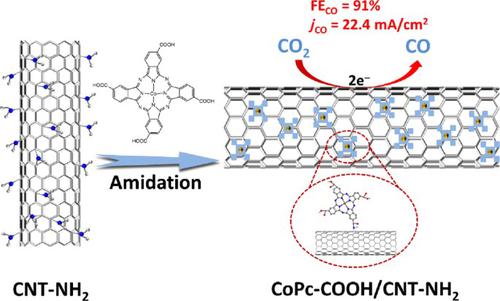Nano Research ( IF 9.5 ) Pub Date : 2022-06-18 , DOI: 10.1007/s12274-022-4578-x Huajian Xu , Huizhu Cai , Linxia Cui , Limei Yu , Rui Gao , Chuan Shi

|
Metal porphyrins and metal phthalocyanines (Pc) constitute a promising class of metal molecular catalysts (MMCs) for efficient CO2-to-CO electrocatalytic conversion due to their well-defined molecular structures. How to adjust the local coordination and electronic environment of the metal center and enhance the molecular-level dispersion of the active components remains as great challenges for further improving the performance. Herein, a cobalt(II) Pc (CoPc)-COOH/carbon nanotube (CNT)-NH2 hybrid catalyst was rationally designed by clicking the CoPc-COOH molecules onto the surface of CNT-NH2 through amidation reaction. This novel hybrid catalyst exhibited the enhanced current density of 22.4 mA/cm2 and CO selectivity of 91% at −0.88 V vs. reversible hydrogen electrode (RHE) in the CO2 electroreduction, as compared with CoPc-COOH/CNT and CoPc/CNT samples. The superior activity was ascribed to the charge transfer induced by introduction of -COOH and -NH2 functional groups to CoPc and CNT, respectively, facilitating the active centers of Coɪ being generated at lower potentials, and leading to the highest turnover frequency (TOF) being obtained over the CoPc-COOH/CNT-NH2 hybrid catalyst. The inherent directivity and saturability of covalent bonds formed via the amidation reaction ensure not only a higher density of Co active centers, but also an improved stability for CO2 reduction reaction (CO2RR). The present study represents an effective strategy for improving MMCs performance by molecular modulating of metal phthalocyanines on functionalized carbon substrates directed by click confinement chemistry.
中文翻译:

钴酞菁在氨基官能化碳纳米管上的分子调控以增强电催化 CO2 转化
金属卟啉和金属酞菁(Pc)由于其明确的分子结构,构成了一类很有前途的金属分子催化剂(MMC),可用于高效的CO 2到CO 电催化转化。如何调整金属中心的局部配位和电子环境,增强活性成分的分子级分散性,仍然是进一步提高性能的一大挑战。在此,通过酰胺化反应将CoPc-COOH分子点击到CNT-NH 2的表面上,合理地设计了钴(II)Pc(CoPc)-COOH/碳纳米管(CNT)-NH 2杂化催化剂。这种新型混合催化剂表现出22.4 mA/cm 2的增强电流密度与 CoPc-COOH/CNT 和 CoPc/CNT 样品相比,在 -0.88 V 与可逆氢电极 (RHE) 相比,CO 2电还原中的 CO 选择性为 91%。优异的活性归因于分别向 CoPc 和 CNT 引入 -COOH 和 -NH 2官能团诱导的电荷转移,促进 Co ɪ的活性中心在较低的电位下产生,并导致最高的转换频率(TOF ) 通过 CoPc-COOH/CNT-NH 2杂化催化剂获得。通过酰胺化反应形成的共价键的固有方向性和饱和性不仅确保了更高密度的Co活性中心,而且提高了CO 2还原反应(CO2 RR)。本研究代表了通过点击限制化学指导的功能化碳底物上金属酞菁的分子调节来提高 MMC 性能的有效策略。































 京公网安备 11010802027423号
京公网安备 11010802027423号